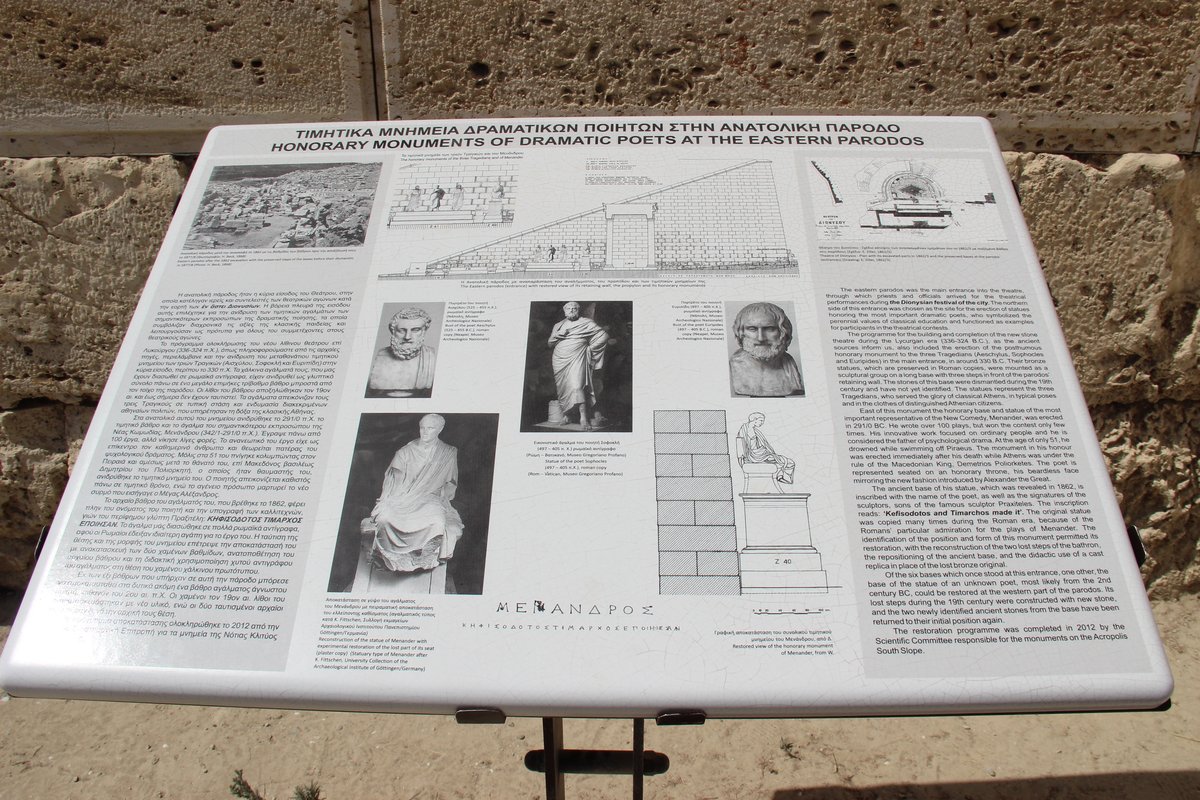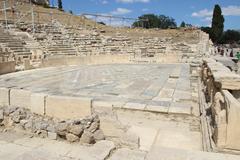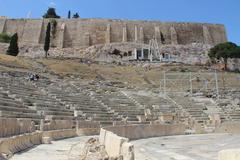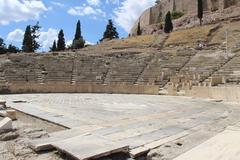
Visiting the Theatre of Dionysus in Athens: History, Tickets, and Tips
Date: 18/07/2024
Introduction
Nestled on the southern slope of the Acropolis in Athens, the Theatre of Dionysus is a monumental testament to the birth and evolution of Western theatre. Revered as the birthplace of tragedy and comedy, this ancient theatre has witnessed the premiere of timeless works by playwrights like Aeschylus, Sophocles, Euripides, and Aristophanes, whose contributions have shaped the dramatic arts for centuries. Beyond its theatrical significance, the Theatre of Dionysus also served as a crucial platform for democratic discourse and social commentary, reflecting the values and societal dynamics of ancient Athens. The theatre’s architectural innovations, including its semicircular orchestra and tiered seating, have influenced theatre construction throughout history, from Roman amphitheatres to modern-day performance spaces. Today, the ruins of the Theatre of Dionysus continue to captivate visitors, offering a tangible connection to the cultural and architectural heritage of ancient Greece. As you stand amidst its weathered stones, you can almost hear the echoes of ancient actors and the applause of Athenian audiences, making it a must-visit for history enthusiasts and theatre lovers alike. (Encyclopedia Britannica, Ancient History Encyclopedia, Ancient Greece, Athens Guide, Khan Academy, UNESCO World Heritage Centre).
Table of Contents
- Introduction
- Historical Significance and Development
- Early Beginnings (6th Century BC)
- Thespis and the Birth of Tragedy (Late 6th Century BC)
- Wooden Structures and Early Performances (5th Century BC)
- The Stone Theatre Emerges (4th Century BC)
- Roman Modifications and Later Use (1st Century BC - 6th Century AD)
- Rediscovery and Restoration (19th Century Onwards)
- Practical Visitor Information
- Cultural and Societal Impact
- Conclusion
- FAQ
Historical Significance and Development
Early Beginnings (6th Century BC)
The theatre’s origins can be traced back to the 6th century BC, initially serving as a simple threshing floor where Athenians celebrated religious festivals in honor of Dionysus, the god of wine, fertility, and theatre. (Encyclopedia Britannica) These early celebrations involved the singing of dithyrambs, choral hymns dedicated to Dionysus, marking the nascent stages of Greek theatre.
Thespis and the Birth of Tragedy (Late 6th Century BC)
A pivotal moment arrived with the legendary Thespis, often credited as the “father of tragedy.” Around 534 BC, Thespis introduced a revolutionary concept—a single actor who engaged in dialogue with the chorus, thus giving birth to dramatic performance as a distinct art form. (Ancient History Encyclopedia) This innovation transformed the dithyrambic chorus into a dynamic interplay between individual expression and collective response.
Wooden Structures and Early Performances (5th Century BC)
As Athenian tragedy flourished during the 5th century BC, the demand for a more structured performance space grew. Wooden seating was introduced, gradually replacing the earlier, simpler arrangements. This period witnessed the rise of renowned playwrights like Aeschylus, Sophocles, and Euripides, whose masterpieces were performed on this evolving stage. (Ancient Greece) Imagine the impact of their timeless works like “Oedipus Rex,” “Antigone,” and “Medea,” captivating audiences within this nascent theatrical setting.
The Stone Theatre Emerges (4th Century BC)
The transition to a permanent stone structure began in the 4th century BC, reflecting the growing importance of theatre in Athenian society. This ambitious project, initiated during the reign of Lycurgus of Athens, replaced the earlier wooden seats with rows of stone benches, creating a more enduring and impressive venue. (Athens Guide) This transformation marked a significant step in establishing the theatre as a permanent fixture in the cultural landscape of Athens.
Roman Modifications and Later Use (1st Century BC - 6th Century AD)
The Theatre of Dionysus did not remain static. Under Roman rule, starting in the 1st century BC, the theatre underwent significant renovations. These modifications, overseen by Roman emperors like Nero and Hadrian, aimed to adapt the space for Roman theatrical tastes, which favored spectacles and gladiatorial combats. (Khan Academy) The orchestra, originally circular, was paved over and reshaped into a horseshoe form, and the stage building was remodeled, reflecting the evolving architectural and theatrical sensibilities of the Roman era.
Rediscovery and Restoration (19th Century Onwards)
After falling into disuse and becoming buried over time, the Theatre of Dionysus was rediscovered in the 19th century, sparking renewed interest in its historical and architectural significance. Archaeological excavations, initiated by the Greek Archaeological Society, gradually unearthed the theatre’s remains, revealing its grandeur and offering invaluable insights into ancient Greek theatre architecture. (UNESCO World Heritage Centre) Today, ongoing restoration efforts strive to preserve the remaining structure, ensuring that this iconic landmark continues to inspire awe and wonder in visitors from around the world.
Practical Visitor Information
Visiting Hours and Tickets
The Theatre of Dionysus is typically open to visitors from 8 AM to 8 PM, although hours may vary seasonally. It is advisable to check the official website or local resources for the most current visiting hours. Tickets can be purchased on-site or online, with prices varying based on age and residency status. Discounts are often available for students and seniors.
Travel Tips and Nearby Attractions
Located in the heart of Athens, the Theatre of Dionysus is easily accessible by public transport, including the metro and local buses. Nearby attractions include the Acropolis Museum, the Parthenon, and the Odeon of Herodes Atticus, making it convenient to explore multiple historical sites in one visit.
Special Events and Guided Tours
Throughout the year, the theatre hosts various special events, including re-enactments of ancient plays and modern theatrical performances. Guided tours are also available, offering in-depth insights into the history and architecture of the site. These tours can be booked in advance and often include access to restricted areas.
Photographic Spots
The Theatre of Dionysus offers numerous opportunities for photography, with its dramatic ruins set against the backdrop of the Acropolis. Visitors are encouraged to capture the essence of this historic site, but it is important to respect the preservation efforts and adhere to any guidelines provided by site staff.
Cultural and Societal Impact
Birthplace of Western Theatre
The Theatre of Dionysus is considered the birthplace of Western theatre. It was here, on the slopes of the Acropolis, that ancient Athenians gathered to witness the birth of tragedy and comedy as we know them. Playwrights like Aeschylus, Sophocles, Euripides, and Aristophanes premiered their works in this very theatre, shaping the dramatic arts for centuries to come. The structure of the theatre, the use of masks, the chorus, and the themes explored in these early plays laid the foundation for theatrical traditions across the globe.
A Platform for Democracy and Social Commentary
Beyond entertainment, the Theatre of Dionysus served as a vital platform for democratic discourse and social commentary. Plays often tackled contemporary political and social issues, encouraging citizens to engage in critical thinking and debate. This tradition of using theatre as a tool for social commentary continues to this day, highlighting the enduring legacy of the Theatre of Dionysus in shaping public discourse.
Architectural Inspiration
The Theatre of Dionysus, with its innovative design and impressive scale, became a model for theatre construction throughout the ancient Greek world and beyond. Its semicircular orchestra, tiered seating arrangement (the theatron), and elaborate stage buildings (skene) influenced Roman theatres and, subsequently, theatre architecture throughout history. Even today, echoes of its design can be seen in modern amphitheatres, demonstrating its lasting impact on architectural design.
A Source of Artistic and Literary Inspiration
The plays first performed at the Theatre of Dionysus have provided an inexhaustible well of inspiration for artists and writers throughout history. From Renaissance paintings depicting scenes from Greek tragedies to modern novels reimagining ancient myths, the themes, characters, and stories originating from this theatre continue to resonate with audiences and creators. This enduring influence speaks to the timeless power of the works first brought to life on its stage.
A Symbol of Athenian Identity and Pride
The Theatre of Dionysus was more than just a place of entertainment; it was a powerful symbol of Athenian identity and pride. Its presence at the foot of the Acropolis, the city’s religious and symbolic heart, underscored the importance of theatre in Athenian society. The festivals held at the theatre, particularly the City Dionysia, were major events that attracted visitors from across the Greek world, further cementing Athens’ reputation as a cultural powerhouse.
Conclusion
The Theatre of Dionysus stands as a powerful symbol of the enduring legacy of ancient Greek theatre and its profound impact on Western civilization. From its humble beginnings as a simple threshing floor to its evolution into a grand stone theatre, this iconic site has witnessed the birth of dramatic arts, democratic discourse, and architectural innovation. The theatre’s historical significance is further underscored by its continued relevance in modern Greece, where it remains a potent symbol of cultural heritage and artistic inspiration. Efforts to preserve and restore the Theatre of Dionysus ensure that future generations can continue to explore its rich history and architectural marvels. Whether you’re a history enthusiast, a theatre lover, or a curious traveler, a visit to the Theatre of Dionysus offers a unique glimpse into the past and a deeper appreciation of the cultural contributions of ancient Athens. Plan your visit today to experience this remarkable landmark and connect with the timeless power of theatre. (Encyclopedia Britannica, Ancient History Encyclopedia, Ancient Greece, Athens Guide, Khan Academy, UNESCO World Heritage Centre).
FAQ
Q: What are the Theatre of Dionysus visiting hours? A: The theatre is typically open from 8 AM to 8 PM, but hours may vary seasonally. Check the official website for the latest information.
Q: How much do tickets to the Theatre of Dionysus cost? A: Ticket prices vary based on age and residency status, with discounts available for students and seniors. Tickets can be purchased on-site or online.
Q: Are guided tours available at the Theatre of Dionysus? A: Yes, guided tours are available and can be booked in advance. These tours provide in-depth insights into the theatre’s history and architecture.
Q: What are some nearby attractions to the Theatre of Dionysus? A: Nearby attractions include the Acropolis Museum, the Parthenon, and the Odeon of Herodes Atticus.
References
- Theatre of Dionysus. (n.d.). Encyclopedia Britannica. (Encyclopedia Britannica)
- Greek Theatre. (n.d.). Ancient History Encyclopedia. (Ancient History Encyclopedia)
- Theatre. (n.d.). Ancient Greece. (Ancient Greece)
- Theatre of Dionysus. (n.d.). Athens Guide. (Athens Guide)
- Theatre of Dionysus. (n.d.). Khan Academy. (Khan Academy)
- Acropolis, Athens. (n.d.). UNESCO World Heritage Centre. (UNESCO World Heritage Centre)























































































